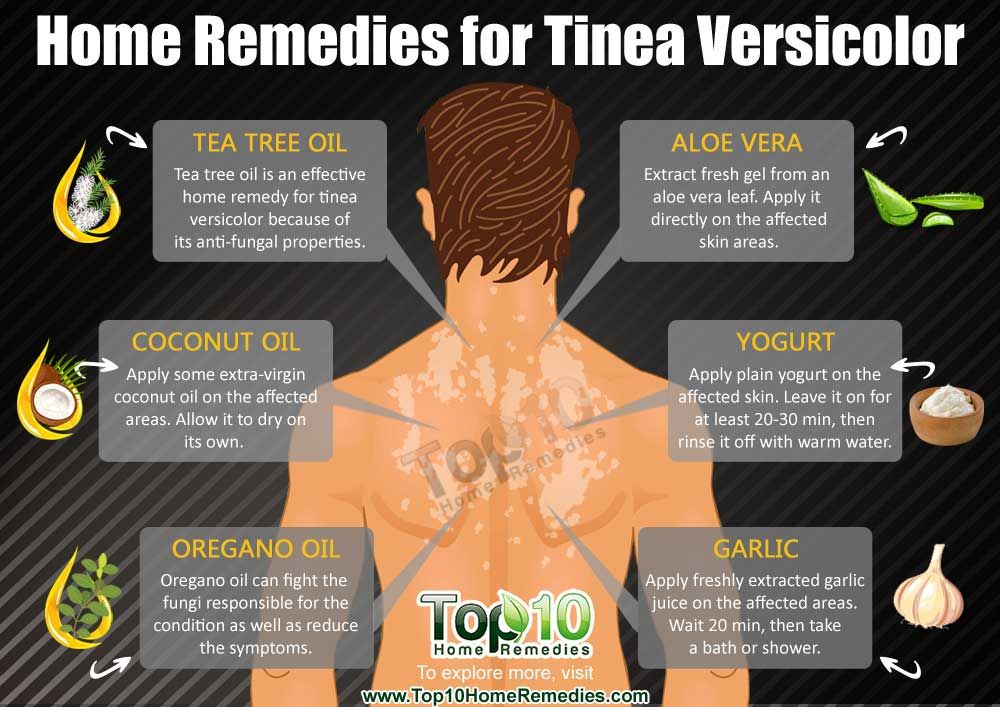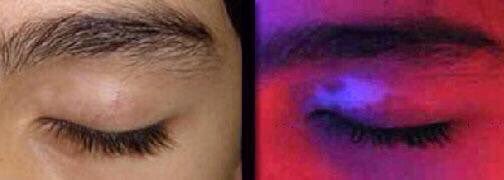Tinea versicolor vs vitiligo pictures. Tinea Versicolor vs Vitiligo: Understanding Skin Pigmentation Disorders
What are the key differences between tinea versicolor and vitiligo. How can you identify these skin conditions. What treatment options are available for tinea versicolor and vitiligo. Why is accurate diagnosis crucial for effective management of skin pigmentation disorders.
Defining Tinea Versicolor and Vitiligo: Two Distinct Skin Conditions
Skin pigmentation disorders can significantly impact an individual’s appearance and self-esteem. Two common conditions that affect skin coloration are tinea versicolor and vitiligo. While these conditions may appear similar at first glance, they have distinct causes, symptoms, and treatment approaches.
How do tinea versicolor and vitiligo differ in their underlying causes?
Tinea versicolor is a fungal infection caused by an overgrowth of the Malassezia fungus, which naturally exists on human skin. In contrast, vitiligo is an autoimmune disorder where the body’s immune system mistakenly attacks and destroys melanocytes, the cells responsible for producing skin pigment.

Tinea Versicolor: Characteristics and Symptoms
Tinea versicolor, also known as pityriasis versicolor, is a common fungal skin infection that affects millions of people worldwide. Understanding its key features can help in early identification and treatment.
Visual Appearance of Tinea Versicolor
What does tinea versicolor look like on the skin?
- Patches of discolored skin that may be lighter or darker than the surrounding area
- Scaly or flaky texture on affected areas
- Mild itching or irritation in some cases
- Common locations include the chest, back, neck, and upper arms
The appearance of tinea versicolor can vary depending on the individual’s skin tone. On lighter skin, it often presents as light brown or pinkish patches, while on darker skin, it may appear as lighter areas.
Factors Contributing to Tinea Versicolor Development
What conditions promote the growth of the Malassezia fungus responsible for tinea versicolor?
- Warm and humid climates
- Excessive sweating
- Oily skin
- Hormonal changes, such as during pregnancy or adolescence
- Weakened immune system
These factors create an environment conducive to fungal overgrowth, leading to the characteristic skin discoloration associated with tinea versicolor.

Vitiligo: Understanding the Autoimmune Skin Disorder
Vitiligo is a chronic autoimmune condition that results in the loss of skin pigmentation. It affects people of all ages, genders, and ethnicities, though its prevalence and impact may vary across different populations.
Recognizing Vitiligo Symptoms
How does vitiligo manifest on the skin?
- Well-defined white patches on the skin
- Gradual expansion of depigmented areas over time
- Possible involvement of hair, causing premature graying
- Common locations include hands, face, and areas around body openings
Vitiligo patches are typically symmetrical and can appear on any part of the body. The condition may progress slowly or rapidly, and its extent can vary greatly among individuals.
Triggers and Risk Factors for Vitiligo
While the exact cause of vitiligo remains unknown, several factors may contribute to its development or exacerbation:
- Genetic predisposition
- Autoimmune disorders, such as thyroid disease or alopecia areata
- Stress or traumatic events
- Exposure to certain chemicals or environmental toxins
- Sunburn or skin injury
Understanding these potential triggers can help individuals manage their condition and potentially slow its progression.

Differential Diagnosis: Distinguishing Tinea Versicolor from Vitiligo
Accurate diagnosis is crucial for effective treatment and management of skin pigmentation disorders. While tinea versicolor and vitiligo may appear similar, several key factors can help differentiate between the two conditions.
Key Differences in Appearance and Texture
How can healthcare professionals distinguish between tinea versicolor and vitiligo based on visual examination?
- Tinea versicolor patches often have a scaly or flaky texture, while vitiligo patches are smooth
- Vitiligo patches have sharp, well-defined borders, whereas tinea versicolor patches may have less distinct edges
- Tinea versicolor can cause both hypopigmented (lighter) and hyperpigmented (darker) patches, while vitiligo only results in depigmentation
- Vitiligo patches are typically larger and more symmetrical compared to tinea versicolor
Diagnostic Tools and Procedures
What methods do dermatologists use to confirm a diagnosis of tinea versicolor or vitiligo?

- Wood’s lamp examination: This ultraviolet light test can help identify the characteristic fluorescence of tinea versicolor
- Skin scraping and microscopic examination: Used to detect fungal elements in cases of tinea versicolor
- Skin biopsy: May be performed to confirm vitiligo diagnosis and rule out other conditions
- Blood tests: Can help identify underlying autoimmune disorders associated with vitiligo
These diagnostic tools, combined with a thorough clinical examination and patient history, allow healthcare professionals to make an accurate diagnosis and develop an appropriate treatment plan.
Treatment Approaches for Tinea Versicolor
Effective management of tinea versicolor typically involves a combination of antifungal treatments and preventive measures to reduce the risk of recurrence.
Topical Antifungal Medications
What are the most commonly prescribed topical treatments for tinea versicolor?
- Ketoconazole cream or shampoo
- Selenium sulfide shampoo
- Ciclopirox cream or gel
- Terbinafine cream
These medications work by inhibiting fungal growth and are typically applied directly to the affected areas for a specified period.
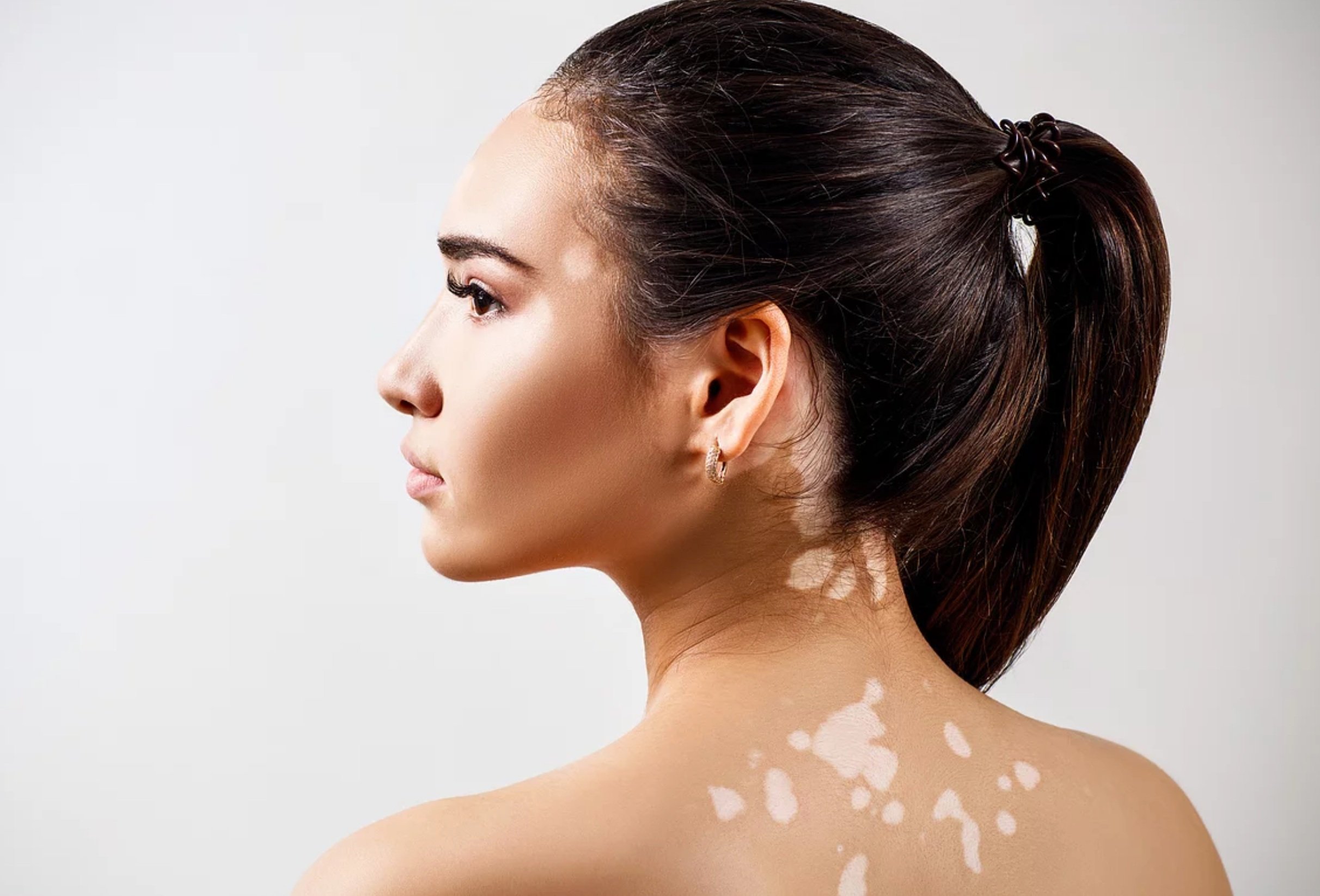
Oral Antifungal Medications
In more severe or persistent cases of tinea versicolor, oral antifungal medications may be prescribed:
- Fluconazole
- Itraconazole
- Ketoconazole (oral form)
Oral medications can be particularly effective for widespread or recurrent infections, but they may have more potential side effects compared to topical treatments.
Lifestyle Modifications and Prevention Strategies
How can individuals reduce the risk of tinea versicolor recurrence?
- Avoid excessive heat and humidity when possible
- Wear breathable, moisture-wicking clothing
- Practice good hygiene and keep skin clean and dry
- Use antifungal shampoos or body washes preventively, especially during warm months
- Avoid sharing personal items such as towels or clothing with others
Implementing these preventive measures can help minimize the risk of tinea versicolor recurrence and maintain healthy skin.
Vitiligo Management and Treatment Options
While there is no cure for vitiligo, various treatment options aim to restore skin pigmentation and improve the appearance of affected areas.
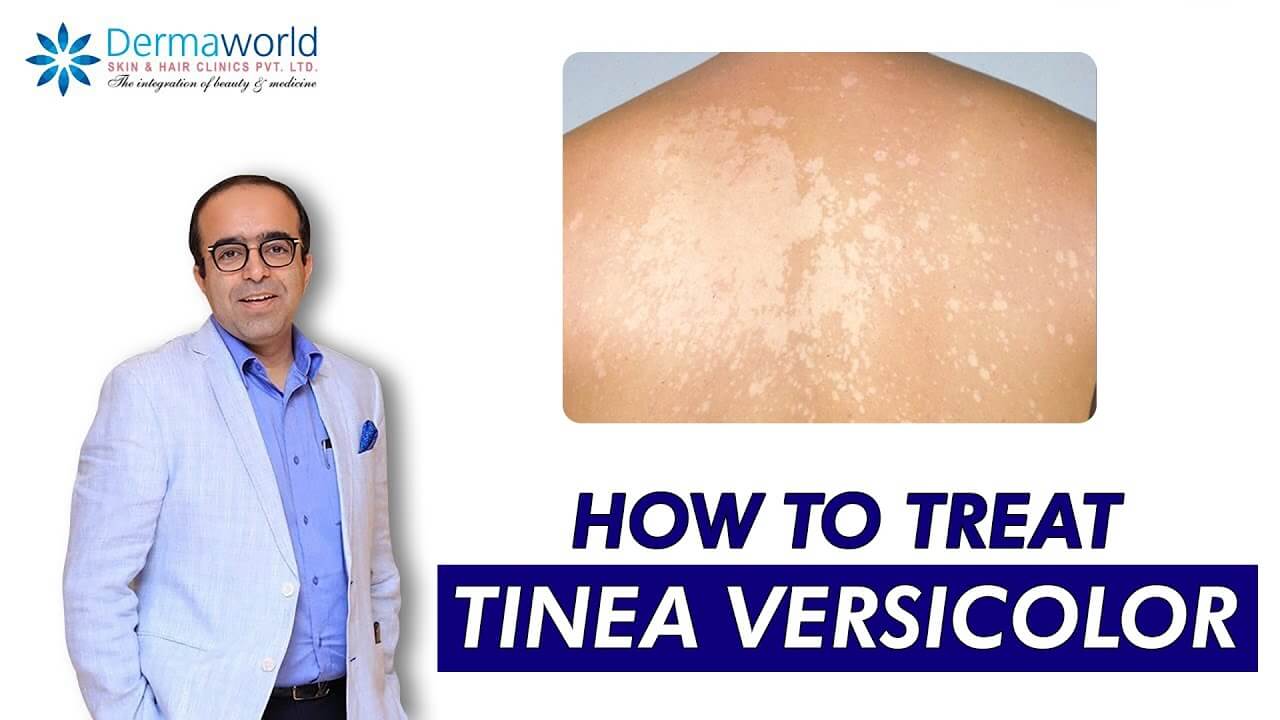
Topical Treatments for Vitiligo
What are the primary topical medications used in vitiligo treatment?
- Corticosteroid creams: Help reduce inflammation and promote repigmentation
- Calcineurin inhibitors (e.g., tacrolimus, pimecrolimus): Immunomodulators that can stimulate melanocyte production
- Vitamin D analogs: May enhance melanocyte function and pigment production
These topical treatments are often the first-line approach for localized vitiligo and may be used in combination for better results.
Light Therapy and Phototherapy
Light-based treatments have shown significant promise in managing vitiligo:
- Narrowband ultraviolet B (NB-UVB) therapy
- Psoralen plus ultraviolet A (PUVA) therapy
- Excimer laser treatment
These treatments work by stimulating melanocyte production and can be particularly effective for vitiligo patches on the face and trunk.
Surgical Interventions for Vitiligo
In cases where other treatments have been ineffective, surgical options may be considered:
- Skin grafting: Transplanting small sections of pigmented skin to depigmented areas
- Melanocyte transplantation: Transferring melanocytes from unaffected areas to vitiligo patches
- Micropigmentation: A form of medical tattooing to camouflage small areas of vitiligo
Surgical interventions are typically reserved for stable cases of vitiligo that have not responded to other treatments.

Psychological Support and Coping Strategies
How can individuals with vitiligo manage the psychological impact of their condition?
- Seek support from mental health professionals or support groups
- Practice stress-reduction techniques such as meditation or yoga
- Explore cosmetic camouflage options to improve confidence in social situations
- Educate friends, family, and colleagues about vitiligo to reduce stigma and misconceptions
Addressing the psychological aspects of vitiligo is crucial for overall well-being and quality of life.
Emerging Research and Future Directions in Skin Pigmentation Disorders
The field of dermatology continues to evolve, with ongoing research aimed at improving our understanding and treatment of skin pigmentation disorders like tinea versicolor and vitiligo.
Advances in Tinea Versicolor Research
What new developments are on the horizon for tinea versicolor treatment?
- Novel antifungal agents with improved efficacy and fewer side effects
- Development of probiotic-based therapies to restore skin microbiome balance
- Research into genetic factors that may predispose individuals to recurrent tinea versicolor
These advancements may lead to more targeted and personalized treatment approaches for tinea versicolor in the future.

Promising Developments in Vitiligo Research
Recent studies have shed light on potential new avenues for vitiligo treatment:
- JAK inhibitors: A class of medications showing promise in clinical trials for vitiligo
- Gene therapy approaches to correct underlying genetic factors
- Stem cell therapies to regenerate melanocytes
- Combination therapies that target multiple aspects of the disease process
These emerging treatments offer hope for more effective management of vitiligo and potentially even reversing the condition in some cases.
The Role of Artificial Intelligence in Dermatology
How is AI technology being integrated into the diagnosis and management of skin disorders?
- Development of AI-powered image analysis tools for more accurate and efficient diagnosis
- Predictive models to identify individuals at high risk for developing skin pigmentation disorders
- Personalized treatment recommendations based on patient-specific factors and disease characteristics
The integration of AI in dermatology has the potential to revolutionize the way we approach skin pigmentation disorders, leading to earlier detection and more tailored treatment strategies.
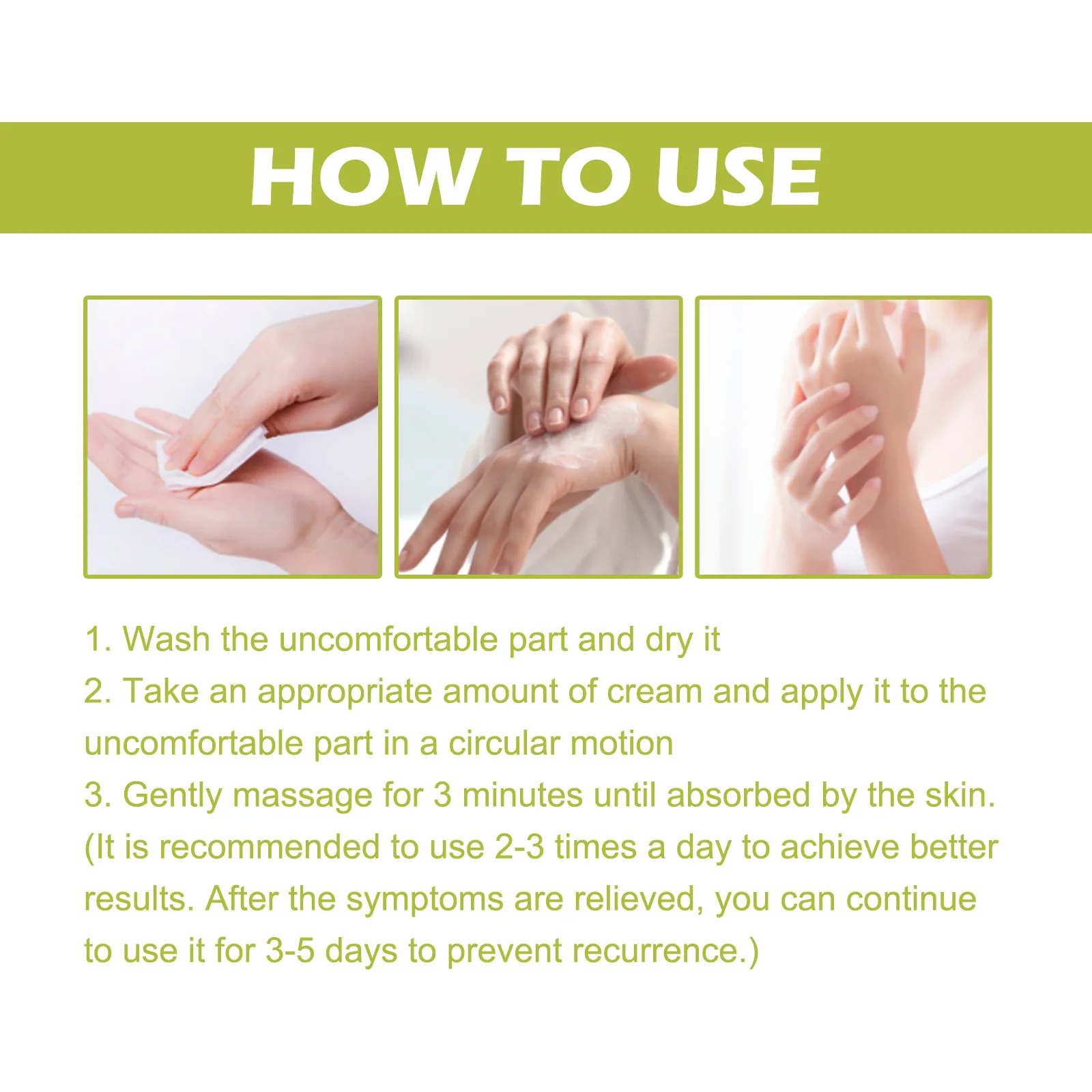
As research in the field of skin pigmentation disorders continues to advance, individuals affected by tinea versicolor and vitiligo can look forward to improved diagnostic tools, more effective treatments, and a better understanding of these complex conditions. By staying informed about the latest developments and working closely with healthcare professionals, patients can optimize their management strategies and achieve the best possible outcomes for their skin health.
Vitiligo vs Tinea versicolor • Cure With Best Homeopathy Medicines
Vitiligo vs Tinea Versicolor can be confusing, as they look very similar. There are more diseases that mimic vitiligo, tinea versicolor, but not as much as these two. Tinea versicolor is a fungal infection caused by the dermatophyte fungus. It typically causes patches of white or light-colored spots on the neck, face, chest, arms, and hands.
Tinea versicolor usually spreads in warm and humid climates but can also occur in cold regions as well. The fungus thrives when sweat mixes with oil from your skin to form an ideal environment for its growth. This produces a yeast-like odor that can be detected by others around you. Though it’s often mistaken for vitiligo because it leaves behind similar skin pigmentation defects, in reality, they are two entirely different conditions!
Vitiligo is characterized by the loss of skin coloration. Vitiligo is an autoimmune disease, meaning one’s immune system attacks their own body. Those with vitiligo are born with the condition and it develops as they age. It tends to afflict people of all races but affects them at different rates in different areas of the world. In some countries, people with vitiligo suffer prejudice or discrimination.
Those with vitiligo are born with the condition and it develops as they age. It tends to afflict people of all races but affects them at different rates in different areas of the world. In some countries, people with vitiligo suffer prejudice or discrimination.
Why Welling Homeopathy Medicines for Vitiligo and Tinea versicolor?
- Our custom-made Homeopathy medicines for skin problems has helped over 42,230 patients globally,
- The CUREplus Homeopathy treatment has cured the most widespread skin eruptions and long duration skin diseases successfully,
- The treatment is non-steroidal, with no creams and no locations. Just natural Homeopathy medicines custom-made for you, for faster recovery,
- Usually, we see a cure in 12-18 months, rarely requiring 24 months,
- The fastest and the safest way to get cured of any skin disease permanently.
Call +91 8080 850 950 to book an appointment or to consult and order online. Consult our specialists today for a detailed evaluation and to start your customized Homeopathy medicines.
Consult our specialists today for a detailed evaluation and to start your customized Homeopathy medicines.
Welling Homeopathy offers treatment for all the above illnesses. I would suggest you consult our specialists in person or online to understand what is the exact diagnosis that you have, then discuss the best natural therapy for vitiligo or tinea versicolor or any other skin disease that you have, and only then start your treatment to get cured.
What is Vitiligo?
Vitiligo is a disorder characterized by the loss of skin coloration while tinea versicolor is a fungal infection that causes scaling and discoloration. Tinea versicolor usually spreads in warm, humid climates and can cause patches of white or light-colored spots on the neck, face, chest, arms, and hands. It’s often mistaken for vitiligo because it leaves behind similar skin pigmentation defects but in reality, they are two entirely different conditions!
What is Tinea Versicolor?
Tinea versicolor, also known as the yeast infection, is an infection caused by a fungus called malassezia.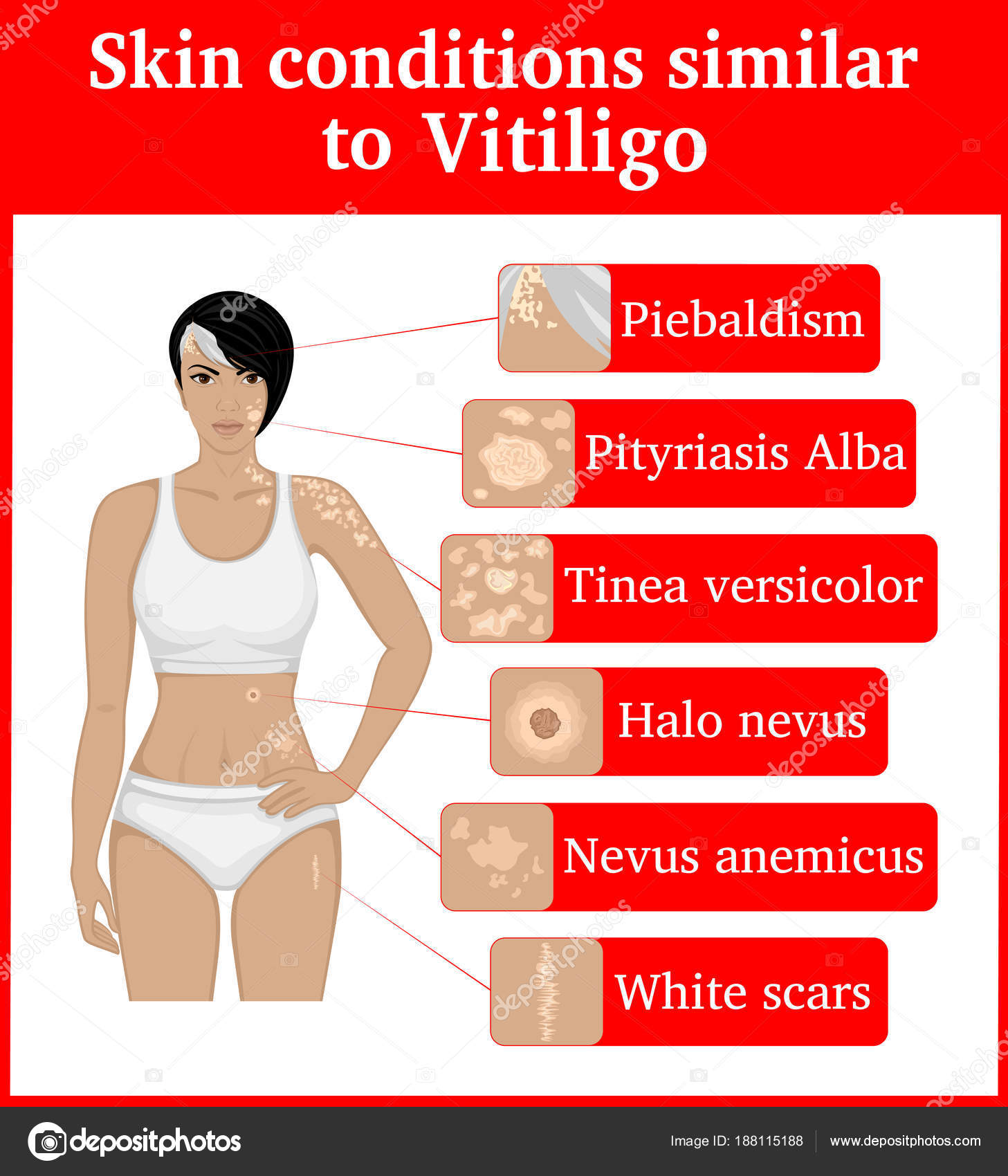 It usually only spreads in moist and warm climates which may cause patches of white or light-colored spots on areas of the body such as the neck, face, chest, arms, and hands. Though vitiligo leaves behind similar skin pigmentation defects, it is not actually tinea versicolor.
It usually only spreads in moist and warm climates which may cause patches of white or light-colored spots on areas of the body such as the neck, face, chest, arms, and hands. Though vitiligo leaves behind similar skin pigmentation defects, it is not actually tinea versicolor.
Tinea versicolor can be spread through contact with an infected person, contact with contaminated items such as towels and clothing, or the overhead air in regions of high humidity. What is Tinea versicolor?
Tinea Versicolor (TV) is one of the most common superficial skin fungal infections and it manifests as discolored, scaly patches on the skin. These patches are usually found on the neck, chest, back and upper arms in people with fair skin (Northern Europeans). TV is caused by dermatophyte fungi (Rhinophyton species) which grow best in warm and humid climates.
It usually affects teenagers and young adults but can affect all age groups. The fungus that causes tinea versicolor grows under the outermost layer of your skin. Most individuals may not even be aware they have this infection due to its mild nature; however, a small number of patients
Most individuals may not even be aware they have this infection due to its mild nature; however, a small number of patients
Vitiligo vs Tinea versicolor
Tinea versicolor is actually not the same as vitiligo. Vitiligo causes patches of skin discoloration and is typically characterized by a lack of melanin. It usually starts on one section of your body, but it can spread to other parts of your body. Tinea versicolor is an infection that causes scaling and discoloration. This fungal infection is usually found in warm, humid climates and often leaves patches of white or light-colored spots on the neck, face, chest, arms, and hands. It’s mistaken for vitiligo because it leaves behind similar skin pigmentation defects but in reality, they are two entirely different conditions!
Treatment For Vitiligo Vs Tinea versicolor
Vitiligo and Tinea versicolor are two very different skin conditions that can be mistaken for one another. While both of them result in patches on the skin, tinea versicolor is a fungal infection caused by fungus while vitiligo is characterized by loss of pigmentation from the skin.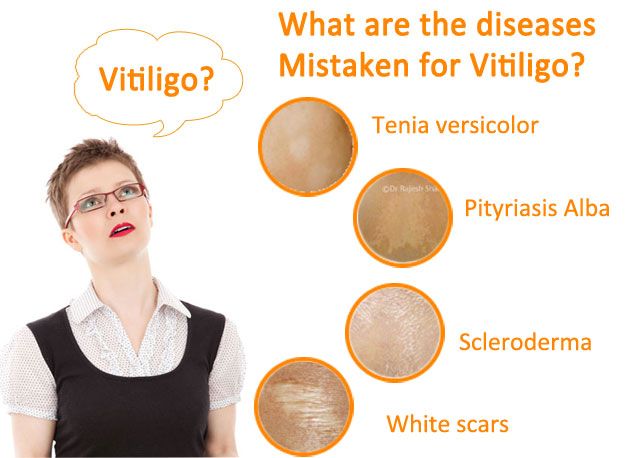 As you can see, they’re not at all alike! If your child has either condition or if you have any other questions about these disorders please do contact us as soon as possible to prevent further complications with their health – we’ll give more information when necessary so don’t hesitate to get in touch today!
As you can see, they’re not at all alike! If your child has either condition or if you have any other questions about these disorders please do contact us as soon as possible to prevent further complications with their health – we’ll give more information when necessary so don’t hesitate to get in touch today!
Call +91 8080 850 950 to book an appointment or to consult and order online. Consult our specialists today for a detailed evaluation and to start your customized Homeopathy medicines.
At a Glance – Vitiligo vs tinea versicolor
By Dr Jean Watkins on the
4 December 2009
Contributed by Dr Jean Watkins, a retired GP in Hampshire.
Vitiligo
Presentation
- Altered pigmentation due to destruction of melanocytes.
- May affect any part of the body, including hair. Most commonly the hands, feet, forearms and face.

- Presents with well-demarcated white or pale round or oval patches, which may be localised or generalised. Skin itself appears normal.
- More obvious in dark-skinned patients or after a holiday when areas of skin fail to tan.
- May follow trauma such as sunburn or emotional stress.
- Often associated with auto-immune problems such as thyroid disease, pernicious anaemia or alopecia areata.
- Usually presents before the age of 30, commonly with a family history.
- Wood’s light highlights depigmented areas.
Management
- Sunscreen to protect depigmented areas that burn rather than tan.
- Topical steroids. Calcineurin inhibitor on the face may help and cause less damage.
- Phototherapy – narrow band UVL or PUVA; or laser therapy.
- If repigmentation fails, depigmentation of normal skin with 20% monobenzylether of hydroquinone may make the vitiligo less obvious.
- Skin grafts occasionally used for small, persistent unchanging areas.

Tinea versicolor
Presentation
- Fungal infection of the skin caused by Malassezia furfur.
- Most common in teenagers and young adults.
- Presents with well demarcated, round or oval, white or reddish brown macules with a fine scale.
- Often first noticed when affected areas fail to tan.
- Most common on trunk, back, abdomen, upper arms and legs.
- Recurrences are common.
- Can confirm diagnosis with skin scraping for microscopy.
- Affected areas may fluoresce yellow-green under Wood’s light.
Management
- Topical selenium sulphide; topical imidazole antifungal agent such as ketoconazole shampoo, clotrimazole or miconazole.
- If persistent or widespread, systemic triazole antifungal agent such as fluconazole.
- Commonly recurs, especially in the immunocompromised.
- Prophylactic treatment with ketoconazole or fluconazole for one to three days each month may prevent recurrences.

Have you registered with us yet?
Register now to enjoy more articles and free email bulletins
Register
Already registered?
Sign in
The voice for today’s GP. News, insights and clinical education.
-
Register today for further access to articles and
daily updates on the issues that matter to you.
Register Now
PCNs are a ‘failed project’ that should be scrapped, warns BMA
PCNs are a ‘failed project’ that should be scrapped – with all their resources moved…
23 Jun 2023
What does the BMA want from the next GP contract?
The BMA has published a ‘call for action’ setting out what it believes general practice. ..
..
23 Jun 2023
BMA demands 50% expansion of GP workforce over next seven years
General practice needs at least 40,000 fully-qualified, full-time equivalent (FTE)…
23 Jun 2023
Junior doctors plan five-day walkout in longest NHS strike ever
Junior doctors will take part in a five-day strike next month in what is thought…
23 Jun 2023
Podcast: NHS workforce plan, the impact of ‘workload dump’ from hospitals, GMC faces no confidence vote
The GPonline team discusses when the NHS workforce plan might appear and what it.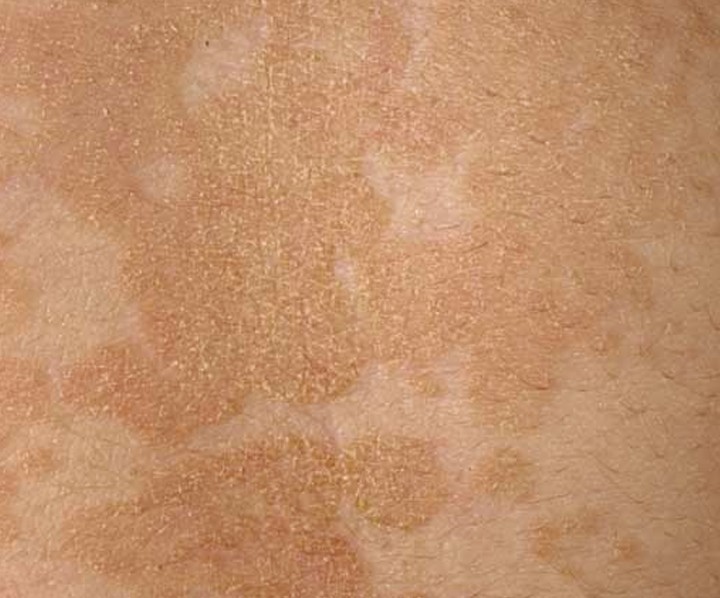 ..
..
23 Jun 2023
GPs hardest hit by ‘vicious cycle’ driving doctors to quit, warns GMC
Doctors are being driven out of the NHS by a ‘vicious cycle’ of heavy workload, dissatisfaction…
23 Jun 2023
Treatment of vitiligo in children in Moscow using UVB (UVB) therapy, prices at the Fantasy Clinic
Vitiligo is a pigmentation disorder. In some areas of the skin, the pigment melanin disappears, spots appear. The discolored areas usually increase over time. Vitiligo can appear on any part of the body.
Vitiligo can appear on any part of the body.
There is currently no 100% effective treatment for vitiligo. You can partially return the pigment, but there is no guarantee that it will not disappear again. We use only proven methods in the treatment of vitiligo and approach therapy in a complex manner. We also use UVB phototherapy (Dermalight 80 device), which gives good results.
Make an appointment via WhatsApp
Video
Prices
Doctors
The first children’s clinic of evidence-based medicine in Moscow
No unnecessary examinations and drugs! We will prescribe only what has proven effective and will help your child.
Treatment according to world standards
We treat children with the same quality as in the best medical centers in the world.
Fantasy has the best team of doctors!
Pediatricians and subspecialists Fantasy – highly experienced doctors, members of professional societies. Doctors constantly improve their qualifications, undergo internships abroad.
The ultimate safety of treatment
We have made children’s medicine safe! All our staff work according to the most stringent international standards JCI
We have fun, like visiting best friends
Game room, cheerful animator, gifts after the reception. We try to make friends with the child and do everything to make the little patient feel comfortable with us.
You can make an appointment by calling
or by filling out the form on the website
Other services of the Dermatology section
Consultation of a pediatric dermatologist
Manipulations, procedures, operations
Removal of papillomas in children
Removal of warts in a child
Removal of molluscum contagiosum in a child
Phototherapy for the treatment of skin diseases
Frequent calls
Treatment of atopic dermatitis in children
Urticaria in children
Seborrheic dermatitis in children
Scabies in a child
Pink lichen in a child
Ringworm in children
eczema in a child
herpes in a child
Acne disease (acne) in adolescents
molluscum contagiosum
Treatment of childhood psoriasis
Allergic dermatitis
contact dermatitis
pyoderma in a child
Warts in a child
Fungal infections in children
Dermatoscopy
Skin mapping
Alopecia in children
Online payment
Documents online
Online services
How to stop the course of vitiligo and what drugs work more effectively?
Vitiligo is considered one of the most mysterious and unexplored dermatological diseases. It is particularly resistant to treatment, leaves noticeable marks on the body and frightens others. What is vitiligo and what to do if the disease has made itself felt?
It is particularly resistant to treatment, leaves noticeable marks on the body and frightens others. What is vitiligo and what to do if the disease has made itself felt?
Vitiligo: acquired or genetic?
Skin color is determined by four pigments: melanin, carotene, hemoglobin and reduced hemoglobin. Any changes in their production are reflected in our body. Especially noticeable is the failure in the production of melanin. Such malfunctions in the body are referred to as acquired skin dyschromia, although every third case of the disease is genetically acquired.
What is important to know when starting to treat vitiligo?
This is not a contagious disease.
It does not increase the risk of skin cancer.
Does not cause itching and pain and, apart from an aesthetic defect, does not harm health.
How the disease manifests itself
In simple terms, vitiligo is a skin pigmentation disorder that is accompanied by depigmented (white) spots. Vitiligo is insidious in that it can manifest itself at any age (especially often in women from 10 to 30 years old). Moreover, not only the skin changes color, but also the hair, fat and sweating practically disappear. Often, against the background of vitiligo, solar dermatitis develops, the color of the eye begins to change, melanin is lost on the mucous membranes. The spots on the skin constantly increase in size, begin to grow together with each other.
Vitiligo is insidious in that it can manifest itself at any age (especially often in women from 10 to 30 years old). Moreover, not only the skin changes color, but also the hair, fat and sweating practically disappear. Often, against the background of vitiligo, solar dermatitis develops, the color of the eye begins to change, melanin is lost on the mucous membranes. The spots on the skin constantly increase in size, begin to grow together with each other.
Diagnosing symptoms is very simple, but starting treatment for vitiligo is the opposite – often the doctor simply does not know which method is best and selects the option by exclusion. Despite the fact that vitiligo spots are almost impossible to confuse with something else, to clarify the diagnosis, the doctor always prescribes examinations for pityriasis versicolor; true, chemical and post-inflammatory leukoderma. It is important to exclude these diseases so as not to aggravate them with improper treatment.
What can cause vitiligo?
Violation of the thyroid gland, adrenal glands, pituitary gland and gonads.

Stress and mental trauma.
Autoimmune causes.
Heredity.
Which method of vitiligo treatment is more effective: drugs or physiotherapy?
A complete cure for vitiligo is almost impossible. Cosmetologists and dermatologists are constantly improving methods, but it has not yet been possible to bring out the ideal method. Nevertheless, you should not refuse treatment. If you can’t get rid of all the spots on the skin, then at least you can always stop their development. And now we are not talking about the method of tattooing, which removes only the outlines of spots and does not guarantee that they will not grow further.
PUVA therapy
The classic treatment for vitiligo. It includes irradiation of affected areas with UV radiation and taking photosensitizing drugs. It is important that only a doctor can choose the optimal dose of drugs, he also regulates the intensity of the UV lamp radiation. Provided that you start treatment on time, normal pigmentation will resume after a few sessions.
Provided that you start treatment on time, normal pigmentation will resume after a few sessions.
It can be external and general – foci of depigmentation are treated with creams, injections, drugs are taken orally.
This includes oral copper preparations and electrophoresis. This therapy is prescribed in combination with another to increase the copper content in the body (this is a typical symptom in vitiligo).
Diet therapy
Doctors recommend eating more seafood and vegetables during treatment. Cod liver, lamb, cabbage, apples, rice, tomatoes, oats, corn are especially useful.
Phytotherapy
It is prescribed as an auxiliary element of treatment – taking decoctions and tinctures with echination, for example, increases the number of T-lymphocytes. The result of herbal medicine can be noticeable only after six months.
For vitiligo, complex treatment is considered the most successful, which includes UV irradiation with a machine (physiotherapy), medication, creams and diet.

